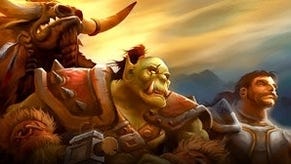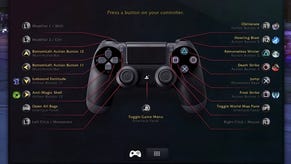World of Warcraft: The Burning Crusade
Blocked your Draenei?
Blood Money
The design of the starting areas for both new races is simultaneously unique and very much in keeping with Blizzard's design ethos for WoW. The Dranaei start on a pair of islands around their crashed interdimensional ship, the Exodar (which may sound like it's hopping into the realms of science fiction rather than Warcraft's normal fantasy setting, but it's a magical spaceship you see), while the Blood Elves kick off their quests in the villages around the beautiful city of Silvermoon, which was the capital of the High Elves before it was ravaged during the events of WarCraft III - one of the more memorable levels in that game, in fact.
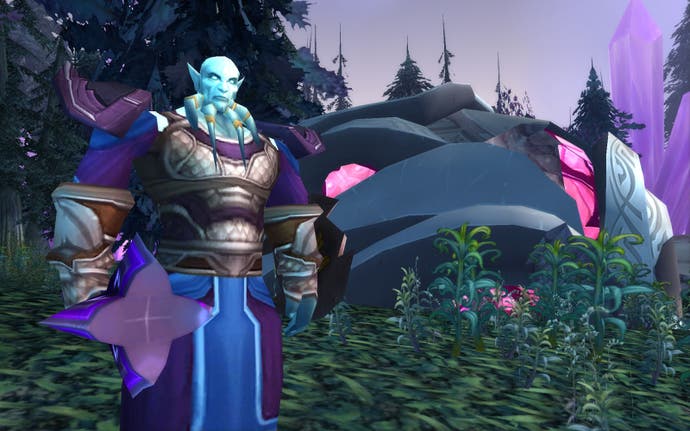
In both cases, the zones in question are richly appointed and provide perfect examples of Blizzard's attention to detail. The islands around the Exodar are scattered with broken pieces from the ship's crash landing, with the landscape dominated by huge glowing crystal formations. The Blood Elf zones, however, are even more dramatic; partially overrun by the undead Scourge, they are filled with fantastically realised contrasts between a formerly beautiful landscape and the rotting plague which has consumed it. The entire area is split in two by the Dead Scar, a blackened slash through the landscape where nothing grows and the mindless undead roam freely - even the city of Silvermoon is divided in two by the scar, which is a fine piece of storytelling through level design, with the Scar serving as a constant reminder of the background to the Blood Elf race.
Overall, there's a feeling that Blizzard have learned much from watching millions of players work their way through the existing starting zones of World of Warcraft, and the new zones represent a new high for the firm's abilities at designing the first few hours of an MMOG. Quests are plentiful, varied and easy to find, and the game has you fighting against minor bosses and a wide variety of enemies from an early stage - but is extremely careful not to overwhelm players who are just getting started, with a beautifully pitched and gradual introduction of new elements as you proceed through the early stages. You'll never be stuck for something to do at any point between level 1 and level 20; each of these zones has been filled with content, and completing a set of quests will generally point you off towards another region where there's yet another set waiting for you.
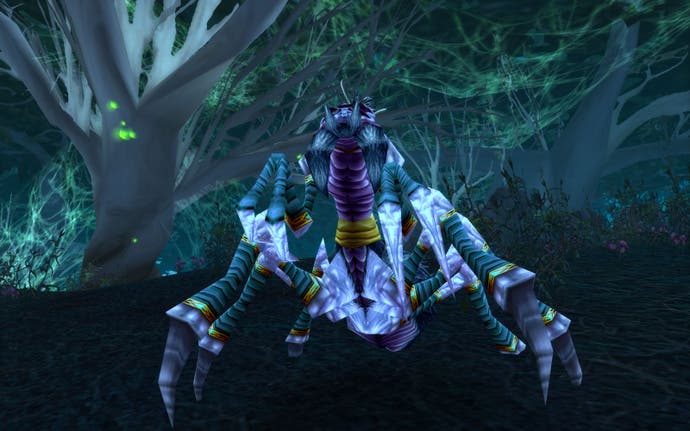
The quests largely take their lead from the more popular or successful quests in other zones of WoW, and experienced players will notice all the key quest types present and accounted for - from straightforward "kill X number of Y monster" quests, to collection quests, exploration quests and even cookery quests. New players, however, will appreciate the variety on offer, and the careful slope of the difficulty curve makes the new zones very enjoyable to play through - while the addition of features like an indicator for how many players it'll probably take to handle a particularly tough quest is an excellent piece of design for players who are unused to MMOG mechanics. Less excellent, perhaps, is the continued over-reliance on making the player walk all around the world for sport; WoW still spends far too much time on travel, and whatever debates may be had over the entertainment value of a level grind, there's no argument over spending hours walking around the place between quest objectives - that's simply no fun at all.
The cities, too, clearly reflect Blizzard's experience of the last few years - they're both relatively clear and easy to navigate (although the fact that the Exodar, which serves as the Draenei starting city, takes quite a while to walk into in the first place is a bit of an annoyance), and tiny features like having postboxes on almost every corner rather than simply one for the entire city, and multiple instances of busy locations like auction houses and inns, should help to spread the population out and keep framerates high.
Burning Desire
If we have one criticism of the new zones, though, it's that their connections to the rest of the game are a little tenuous. The Blood Elves can teleport instantly to the undead city, The Undercity, while a boat from a small dock next to the Exodar bears the Draenei away to a low-level area from which they can explore the rest of the world of Azeroth - but when you hit level 20 and strike out beyond your starting zones, the sense of progression doesn't seem as clear as it is for the other races, for whom the various zones of the game tend to follow fairly logically from one another. As superbly designed as the new zones are, they feel somewhat tacked on to the existing world - a minor criticism, but still a little jarring for a player who's just got into the swing of their character and suddenly finds themselves flung into the wider world.
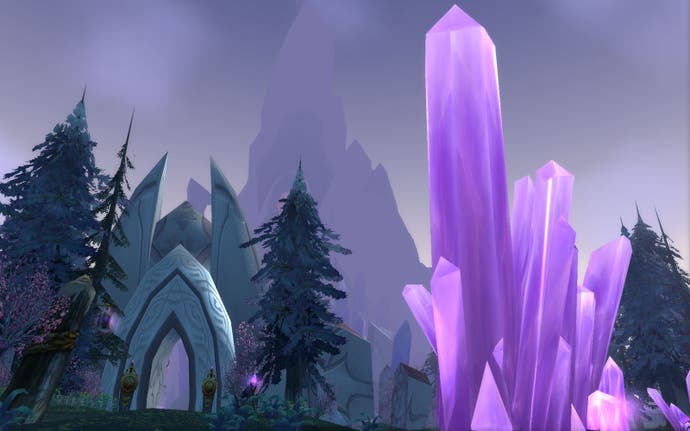
But to Blizzard's credit, they have populated the rest of the existing world with Draenei and Blood Elf quests and NPCs (although we've yet to see how extensive this addition is at high levels), so it's not like you suddenly feel like your race is an outsider to the game once you get past level 20. The existing zones of the game still look fine graphically, too - perhaps not quite as neatly designed as the new areas in some respects, but this owes more to the improving skills of Blizzard's artists than to any actual technical difference in the new regions.
That improvement isn't just noticeable in the fantastic environments, beautiful cities and gorgeous, detailed player and monster models which have been created for this expansion - it's also clear from the presentation of the Burning Crusade as a whole. The hugely impressive intro video is one aspect, the gorgeous visuals another; the music, too, is worth a mention, with both new races having unique soundtracks to their zones. There's a mellow, almost tribal rhythm to the Draenei musical score, while the Blood Elf score stands out as particularly superb - filled with haunting, melancholic choral pieces and genuinely evocative melodies.
As to whether players who are starting out as members of the new races will find themselves wanted by teams tackling Azeroth's various challenges; yes, certainly. Horde teams will want paladins and Alliance teams will want shamans, of course - both classes are quite unique and useful in their own right, and once the novelty wears off they'll almost certainly settle down to become well-integrated classes with clear roles to play. The racial benefits of both new races will also be useful, of course - while the entirely new trade profession which has been introduced, Jewelcrafting, enables players to create and sell trinkets such as necklaces, earrings and rings, which were previously much harder to get hold of and far less varied in their function. Draenei get a bonus to this profession (which will also at higher level allow the creation of gems which slip into sockets on specific items, giving them stat bonuses), and it's likely to be a mainstay trade of many players of the new races.
A Just Crusade?
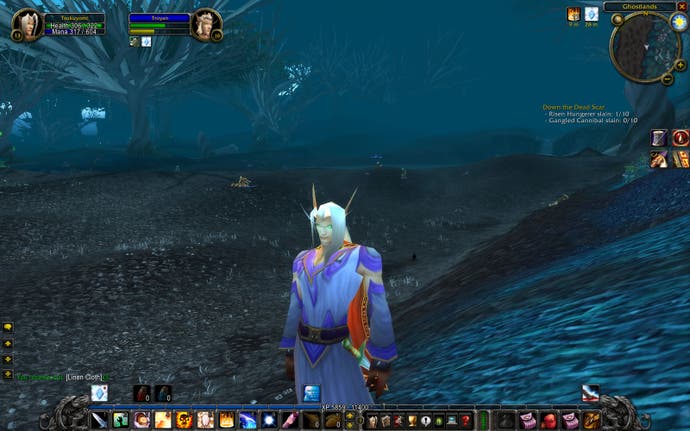
Existing players of World of Warcraft who are already at level 60 have probably already bought The Burning Crusade; for those who are not, or those who have not played the game yet, the burning question (sorry) is whether this expansion pack really adds anything of value for new players, or for players starting anew.
The answer to that question is both yes and no. It is very much an expansion pack, after all; there are no significant new gameplay modes added to the early game, and the basic mechanics of how quests, combat, crafting and trading work are all exactly the same as previously, with few tweaks to a formula which has already proved to be hugely successful. If that formula left you cold before, it's unlikely that The Burning Crusade will change your mind, and the small tweaks on offer still don't fix fundamentally dull pieces of game design like the lengthy travel time between quest objectives.
On the other hand, there is no denying that The Burning Crusade is a triumph of design - in so much that it is everything which made World of Warcraft popular, fun and exciting, distilled down and refined by the developers after years of experience. The two new races represent the most polished and enjoyable way to enter the world of Azeroth - or, indeed, to enter the world of MMOGs in general - which makes The Burning Crusade's low-level content into an extremely welcome addition to an already excellent RPG.
Bear in mind that this verdict reflects our view solely of the low-end content in the expansion - the two new races and their starting zones, based on playing from level 1 to 20. We'll be playing the high level (60+) content further down the line, and giving that a proper once-over in the not too distant future...

